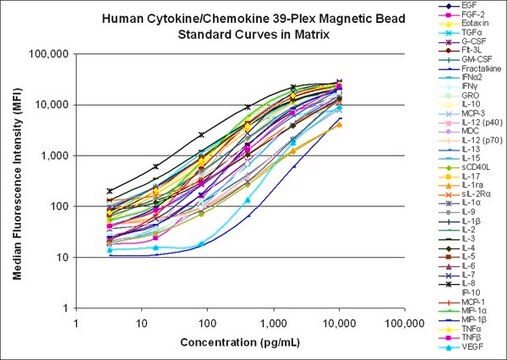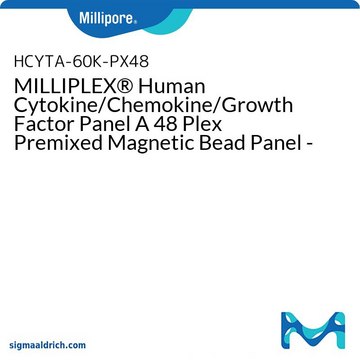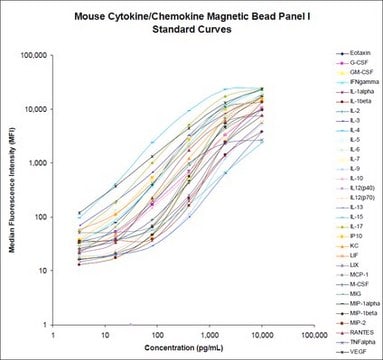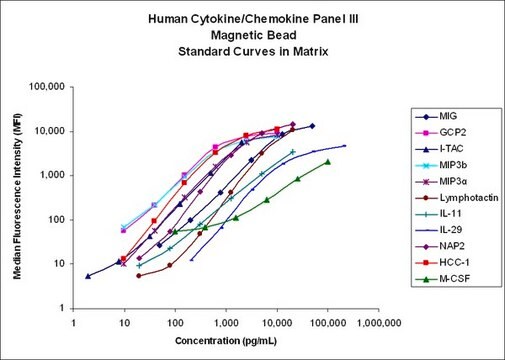HCYTMAG-60K-PX41
MILLIPLEX® Human Cytokine/Chemokine Magnetic Bead Panel - Premixed 41 Plex - Immunology Multiplex Assay
Simultaneously analyze multiple cytokine and chemokine biomarkers with Bead-Based Multiplex Assays using the Luminex technology, in human serum, plasma and cell culture samples.
Synonym(s):
Human cytokine multiplex kit, Luminex® human cytokine immunoassay, Millipore human cytokine panel
About This Item
Recommended Products
species reactivity
human
manufacturer/tradename
Milliplex®
assay range
accuracy: 87-107%
standard curve range: 3.2-10,000 pg/mL
technique(s)
multiplexing: suitable
compatibility
configured for Premixed
detection method
fluorometric (Luminex xMAP)
shipped in
wet ice
General description
The MILLIPLEX® Human Cytokine / Chemokine Panel 1 enables you to focus on the therapeutic potential of cytokines as well as the modulation of cytokine expression.
The Luminex® xMAP® platform uses a magnetic bead immunoassay format for ideal speed and sensitivity to quantitate multiple analytes simultaneously, dramatically improving productivity while conserving valuable sample volume.
Panel Type: Cytokines/Chemokines
Specificity
Cross-reactivity between the antibodies and any of the other analytes in this panel is non-detectable or negligible.
Application
- Analytes: sCD40L, EGF, Eotaxin/CCL11, FGF-2, Flt-3 ligand, Fractalkine, G-CSF, GM-CSF, GRO, IFN-α2, IFN-γ, IL-1α, IL-1β, IL-1RA, IL-2, IL-3, IL-4, IL-5, IL-6, IL-7, IL-8, IL-9, IL-10, IL-12 (p40), IL-12 (p70), IL-13, IL-15, IL-17A, IP-10, MCP-1, MCP-3, MDC (CCL22), MIP-1α, MIP-1β, PDGF-AA, PDGF-AB/BB, RANTES, TGF-α, TNF-α, TNF-β, VEGF
- Recommended Sample type: Serum, plasma, or tissue/cell lysate and culture supernatant samples
- Recommended Sample dilution: Neat plasma or serum. Tissue culture supernatant may require a dilution with an appropriate control medium prior to assay. RANTES, PDGF-AA and PDGF-AB/BB require a 1:100 dilution of plasma/serum samples.
- NOTE: RANTES, PDGF-AA and PDGF-AB/BB cannot be plexed with other cytokines in this panel due to a required 1:100 dilution of plasma/serum samples.
- Assay Run Time: Overnight or two-hour primary incubation. For best results, an overnight incubation is recommended
- Research Category: Inflammation & Immunology
- Research Subcategory: Obesity, Metabolic Disorders, Inflammation & Autoimmune Mechanisms
Packaging
Storage and Stability
Other Notes
Legal Information
Disclaimer
Signal Word
Danger
Hazard Statements
Precautionary Statements
Hazard Classifications
Acute Tox. 3 Dermal - Acute Tox. 4 Inhalation - Acute Tox. 4 Oral - Aquatic Chronic 2 - Eye Dam. 1 - Skin Sens. 1 - STOT RE 2
Target Organs
Respiratory Tract
Storage Class Code
6.1C - Combustible acute toxic Cat.3 / toxic compounds or compounds which causing chronic effects
Certificates of Analysis (COA)
Search for Certificates of Analysis (COA) by entering the products Lot/Batch Number. Lot and Batch Numbers can be found on a product’s label following the words ‘Lot’ or ‘Batch’.
Already Own This Product?
Find documentation for the products that you have recently purchased in the Document Library.
Our team of scientists has experience in all areas of research including Life Science, Material Science, Chemical Synthesis, Chromatography, Analytical and many others.
Contact Technical Service











